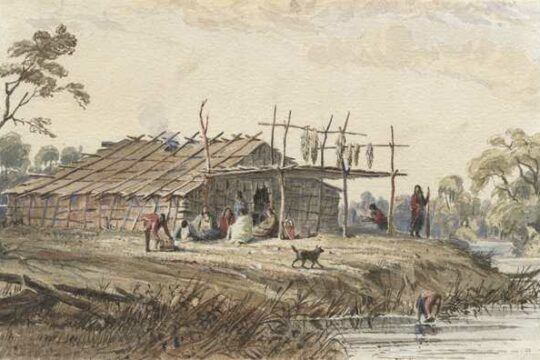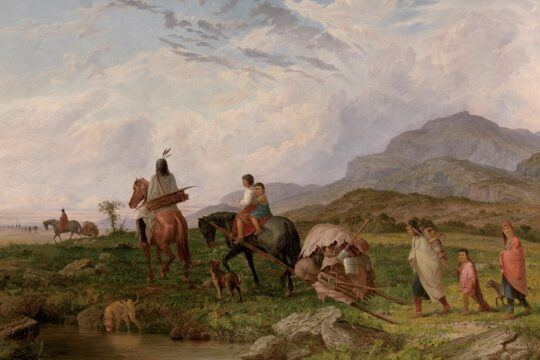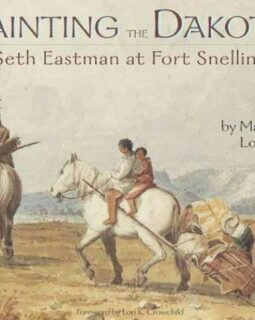Dakota of Cloud Man’s Village

Cloud Man
Maȟpíya Wičhášta (Cloud Man) was born between 1785 and 1795. He was a skilled hunter and warrior. He fought for the British in the War of 1812 and subsequently fought with them to retake Prairie du Chien from the Americans; he received medals from the British for these efforts. He lived in Black Dog’s village on the bank of the Minnesota River which numbered approximately forty families and was raised to the rank of head warrior in that village. In Two Volunteer Missionaries, Samuel Pond characterizes the Dakota leader as “respected and loved by his people.”
The particularly harsh winter of 1828-1829 nearly devastated the village. At the time, Cloud Man was trapped on the prairie searching for game and nearly starved. Cloud Man decided that if he survived, he would take up the new methods of agriculture brought by the Americans.
Cloud Man established a site between Bde Maka Ska and Lake Harriet called Eatonville. The Dakota called it Ȟeyáta Othúŋwe or “The Village at the Side”. In 1834, Samuel and Gideon Pond were encouraged live among Cloud Man’s band. The Pond brothers were lay missionaries who brought farming and carpentry skills to the village. Cloud Man selected the location for the brothers’ cabin, saying that from that point, “the loons would be visible in the lake. The village retained semi-nomadic lifestyle with this as their summer village.

Seasonal Life
Traditional Dakota life was semi nomadic. Each village moved throughout the year, living in Tipi during the fall, winter and spring and returning to their bark lodge villages during the summer. Cloudman’s village incorporated western agricultural techniques during the summer while hunting, fishing, gathering maple sugar and wild rice seasonally.
“The seasonal cycle never ended, but it did vary from year to year depending on weather, war, and rotation of land use. Managing the cycle required the combined knowledge of many band members, who passed on their experiences through the generations.” –Mni Sota Makoce: The Land of the Dakota. Gwen Westerman & Bruce White.
Restored prairie, tipi, native fruit trees, a replica bark lodge, medicine and crop gardens set the background for Gibbs Farm’s Dakota program. This seasonal life curriculum was developed with Cloud Man descendants and historical sources.
Further Reading
Painting the Dakota: Seth Eastman at Fort Snelling
Marybeth Lorbiecki, Foreword by Lori K. Crowchild (Native American descendant of Seth Eastman)Readers learn about Dakota culture through Seth Eastman paintings. Painted during seven years on the frontier, these watercolor and oil paintings comprise the most significant source of information about Native American life in pre-territorial Minnesota. Softcover. Member Price: $15.00; Non-Member Price: $16.00. Order books here.
Ramsey County History – Spring 2000: “Gummy, Yellow, White Flint Corn—The Dakota Garden at the Gibbs Museum”
Janet CassGummy, Yellow, White Flint Corn—The Dakota Garden at the Gibbs Museum Author: Janet Cass At the Gibbs Farm, which was established by Jane and Heman Gibbs in 1849 outside St. Paul, the museum there offers a view of pioneer and native gardens side-by-side. These demonstration plots allow visitors to…
